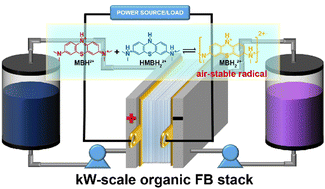Insights into an air-stable methylene blue catholyte towards kW-scale practical aqueous organic flow batteries†
Abstract
Aqueous organic flow batteries (AOFBs) possess unique advantages, including element abundance and tailorability, compared to the traditional flow batteries (FBs). However, achieving an air-stable and high-performance electrolyte is still one of the main challenges for their practical applications. Generally, the stability of an aqueous organic electrolyte is associated with the structure of the organic redox-species and electrolyte environment. By the virtue of electrolyte optimization and in situ/ex situ NMR and EPR techniques, we found in the methylene blue (MB) electrolyte that both oxygen-resistant MB radicals generated by the comproportionation reaction and reduced MB states in the acidic electrolyte displayed much more stable molecular structures. This definitely plays a vital role in the high reversibility of MB molecules under ambient air conditions. Taking advantage of the air-stable MB electrolyte, a kW-scale AOFB stack was assembled for the first time, which exhibited stable capacity at 80 mA cm−2 for over 500 cycles. Moreover, the stack based on 0.5 M MB electrolyte still achieved a stable long-life cycle performance for ∼32 days with a capacity of ∼510 A h. The impressive stack performance enables the MB catholyte to be a promising candidate for large-scale energy storage.



 Please wait while we load your content...
Please wait while we load your content...